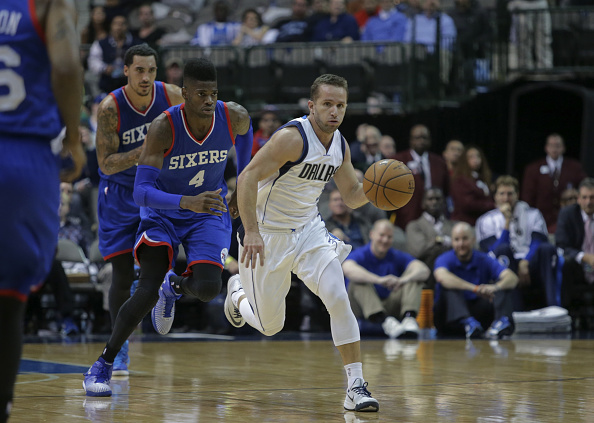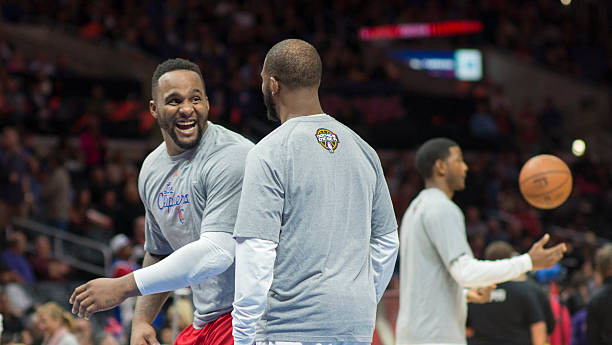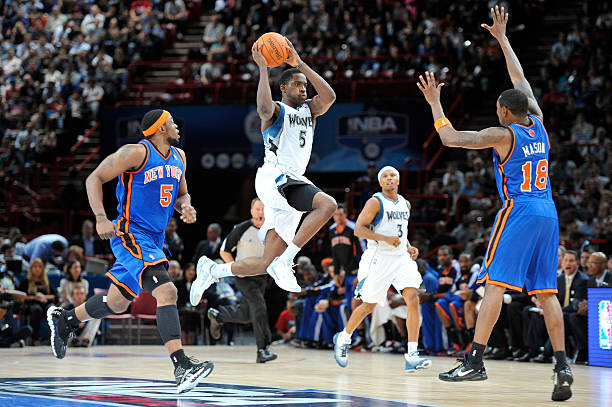Josh Elias | December 16th, 2018
If there’s one thing that’s talked about more than anything when it comes to basketball, it’s ‘the GOAT question’. Who is the greatest of all-time? Almost everyone says either LeBron James or Michael Jordan, with the occasional instance of Wilt Chamberlain, Bill Russell, Kareem Abdul-Jabbar, Larry Bird, Magic Johnson, or Kobe Bryant.
Perception and How To Decide
To grossly oversimplify the question, the answer comes down to who did the best against the best competition.
Now, obviously, everyone has different criteria of what “the best” means. Accolades? Stats? Natural Ability? The eye test? Advanced metrics? Some combination of all of those?
There are going to be large quantities of people that base their decisions on each of those things, although, if you’ve been involved in this conversation enough times, you already know that.
Something that we often take for granted though is a lack of a serious analysis of who’s competition was/is the best. We kind of just assume the current era is better than the previous era, and so on, and so forth, but we forget to take into account that progress doesn’t happen in a straight line in every situation.
People remember what’s memorable. (Well, duh.)
My point in saying that is that, just like people oftentimes count finals wins as mattering a bit too much in this debate, they also only look at the opponents with big names, star power, and memorable moments. Which makes sense on a level.
But Dr. J doesn’t entirely define the 70’s, Shaq doesn’t entirely define the 00’s, and Stephen Curry doesn’t entirely define today.
Why don’t we ever consider the average players; who the average opponent LeBron and Wilt and MJ faced off against is?
Well, because it’s a hard question that involves a lot of numbers, that’s probably the biggest reason. It’s not as sexy as just looking at the stars, but it’s just factually a more accurate question to pose.
Luckily, I like role players, and I’m good enough at Google Sheets to minimize the pain of the numbers for myself. Hopefully, this can provide a lot of context for various NBA debates.
The Average Point Guard: ’50s to Now
Today let’s take a look at the evolution of the point guard position.
You may freely eat of every tree of the garden; but of the tree of the knowledge of playmaking and ball-handling you shall not eat, for in the day that you eat of it you shall die. 1 Stockton 2:16-17
Way back in the 50s in the infancy of basketball, the game was much slower than it was now, but once the shot clock was introduced, there was actually pretty fast-paced basketball. Although it was almost completely unrecognizable from what it is today.
The point guard position, in particular, was a very important position even back then, although the most successful point guards generally weren’t scoring guards.
The average point guard averaged a hint under 8.4 points a game, and slightly more rebounds than assists, thanks to how assists were counted back then. Steals, blocks, and turnovers weren’t counted yet, so we have no way of telling how they were at that. Field goal percentages in general throughout the league were painfully low.
Without a shot clock in college, or before 1954-55 for the pros, it was a drastic change to the game that took quite a while to figure out how to create efficient shots afterward, and point guards specifically shot only 35.5% through the whole decade.
Basically, it was a very important position that very few people were actually good at.

As they moved into the sixties, the game shifted to allow guards to be more of a scoring threat. Assists started being counted more easily, and taller point guards like Oscar Robertson would really shake things up.
In general, they began to add driving and cutting more into their games, but the increased size and strength of the big men stopped them from being able to get in the paint on defense to take rebounds away from them, a trend that would continue for quite a while.
The average point guard would average 10.8 points, about 3 rebounds, and 4 assists, and shooting percentages would go up by 6%.

The 70’s: Looking purely at the basic statistics, it would appear like this was the heyday of the position. Scoring was up, assists were up, steals were higher than they have been in any decade since, and blocks were only matched by this current decade. Field goal percentage was up to 45%, and the score-first point guard would thrive in the form of smaller, speedy guards like Tiny Archibald and Calvin Murphy.
Of course, a big reason for that was that the ABA took away many of the biggest-name forwards, like Rick Barry, Julius Erving, and Zelmo Beaty, leaving the star point guards to figure it out for themselves. This pacy, iso-filled game was often driven by this position as much as, if not more than, the posts, a big change from previous decades.
11, 2 1/2, and 4 1/2; those are the stats we’ve got here.

The era of Magic and the beginning of Stockton, the ’80s saw their position go along with the trend as much as possible, and the average point guard at this point gave up a couple points in order to reach 5 assists.
While assists went up by a lot, turnovers actually went down by a little at the same time. Rebounds were down to an all-time low, with just 2.2 a game for Mr. PointGuard McAverageFace.
The introduction of the three-point line saw that enter their repertoire with a whimper, shooting below 30% from three-point range on three attempts per five games.

It was more of a half-court offense than before, and a bit more of one than later too, as the 1990s saw a very mixed offensive system, with both quite a few fast breaks and lots of very deliberate, slow offensive half-court plays.
Point guards began to actually take a bit of an off-ball role to an extent, and spotted up more, tripling their three-point attempts and increasing their percentage on those threes up to about a respectable 35%.
Field goal percentage fell as three-point attempts rose, and thanks to an increase of ball-dominant wings and Jordan copycats, most of their stats slightly fell.
But they did see a very small increase in rebounds from the previous decade, for the first time ever. Steals falling as much as they did though certainly was a troubling sign defensively.

And a lot of those signs continued into the next decade. We saw steals drop again significantly, down to less than one per game at this point – 0.93. That’s a 0.17 per game drop from the previous decade, and 0.33 from the decade before that. Obviously, that was exacerbated a lot by the hand check rule now being an official rule.
We also saw a continuation in that rise of guards who spot up more often and saw more of the shooting guards taking over. Points went a bit down, rebounds kept going a bit up, assists decreased considerably, worse than they ever had, and as there weren’t really too many superstar shooters aside from Steve Nash, we saw three-pointers go up, while not as much as you’d probably expect. Along with that, three-point percentage stayed pretty much the same, while field goal percentage went down considerably, back to nearly the level that it was in the ’60s.

This decade though, quite a bit of what a lot of people would characterize as a revival has taken place. Points-per-game actually increased by more than one point per game for the first time since the transition from the ’50s to the ’60s.
Rebounds continued to go up a little bit, assists continued to go up a little bit, steals stayed the same, blocks went up a little bit, field goal percentage stayed about the same, three-point percentage increased a little, but attempts from behind the arc skyrocketed.
At this point there are now about 4 1/2 times as many three-point attempts as there were when it was introduced in the ’80s, at 2.7 per game for the average point guard, and with the type of point guard that keeps coming into the league, that’s something that’s almost certainly going to keep going up.

The Average Point Guard Personified
That’s the story told through stats, now let’s tell it through players.
The average point guard for the 1950s was George Senesky.

Don’t worry, no one expects you to know who George Senesky is. If you do though, you’re my new best friend.
Senesky was in the BAA/NBA from 1946-47 to 1953-54. He won one title with the Warriors and had career averages of 7, 3, and 3. Now, for each decade’s most average player, I’m talking about how they did within that decade, which for Senesky in the ’50s is 7.2 points, 3.5 rebounds, and 3.9 assists.
Since there’s no game tape of him, I can’t give you a great idea of what his playstyle was like, but based on the fact that he was a very successful coach, I would assume that he was a high IQ floor general type of player who had more of a playmaking role than anything else. Based on box scores he wasn’t ever the type of player to try to take over a game either.
As the game heads into the sixties, we start to see a slightly more recognizable name, but someone most people probably still wouldn’t know too well.
Wali Jones is the average point guard at this point, and he’s a guy who kind of exemplified the start of the jump shot becoming a necessary part of every guard’s game. He was very good at opening up floor spacing, providing contending teams with a guy who could what would today be considered a deep mid-range shot. He had pretty solid playmaking skills, very good vision, and ball-handling, and he was the king of the ball fake. That’s notable because we know that that was stylistically, as well as just statistically, the direction the league was heading in.

In the 1970s, the average player became Jim McElroy, and I think that he’s fitting to represent, the ’70s, actually. For a few years, early on in his career, he was pretty much the perfect role player. In fact, he was the point guard alongside “Pistol Pete” Maravich, and he was very solid defensively and quite efficient. All-around he was just a great teammate to have.
During a season where Maravich was injured, he exploded for averages of 17 points and almost 6 assists a game, but then by the age of 29, he was out of the league.
For as chaotic of a period that the ’70s were for basketball, the seemingly random path McElroy’s career took is perfect.

In the ’80s, the average point guard was embodied in Frank Johnson, and I would say that makes a good amount of sense as well. He was a pretty athletic player, and a hard-nosed, hard-working guy, but didn’t have a lot of flair or nuance apparent in his game.
He was, again, very much a system player, although, for a couple years, that system did him very well. He had a season where he averaged 8 assists, followed up by one where he averaged 7.
His averages during the eighties, for the Bullets and a season with the Rockets, were about 9.5 points, 4.8 assists; generally very similar numbers to the league averages for the decade. Not a very good shooter certainly, which is to be expected for the era.
Also, a representation for the era are the troubles of Frank’s brother. “Fast Eddie” Johnson was a two-time all-star in the early ’80s for the Hawks before getting banned from the NBA for a cocaine addiction and is now serving a life sentence without the possibility of parole for child molestation.
https://www.youtube.com/watch?v=mEhwiuPYD0U
In the ’90s, that average player became Johnny Dawkins, and that’s a name that more than a dozen of you will actually know for once here. If nothing else, at least for being the Stanford coach for almost a decade.
He was a solid player in the league for quite a while. He did have injuries mess with his career, but he had four seasons where he averaged over 14 points a game and around 7 assists to go with it.
Certainly, a sign of the evolution of the position wherein more athletic players became more prevalent. He was even in the dunk contest one year.
He did badly in it, but he was in it.
Either way, let’s just say I wouldn’t be angry with being in an era where he’s considered average.
Then moving into the 2000s, we have the average player as Alvin Williams. He definitely embodies more of that off-ball persona that was starting to pop up more around this time, to the extent where he actually played more shooting guard than point guard in three of his nine years.
He was a great threat whenever he drove to the basket because, as well as an ability to actually get to the rim, he also had a very quick release that would allow him to pull up for a jumper in the middle of a drive before the defender even had time to react. He was a pretty underrated defender before injuries took his lateral quickness away too.
That all leads up to who the average point guard is right now, in this current decade, and the answer is…
J.J. Barea. That certainly surprised me when I saw his stats match up to the average better than anyone else, but it’s true. You already know about this tiny little magician, so I’m not going to make this any longer than it has to be by adding in Barea analysis, aside from saying, please vote for him for the sixth man of the year this year. He deserves to have an end-of-season award.
Questions and comments?
thescorecrowsports@gmail.com
Follow Us on Twitter @thescorecrow
Follow Us on Reddit at u/TheScorecrow
Follow Josh Elias on Twitter @_SunsofThunder_
Main Credit Image: [getty src=”458960592″ width=”594″ height=”423″ tld=”com”]






